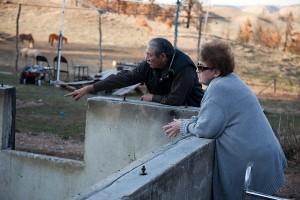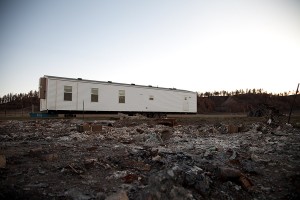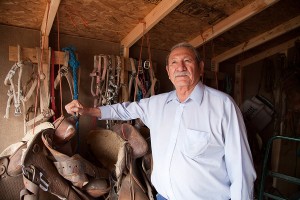My story for the University of Montana's Native News Project, which is in its 22nd year. The stories ran in two Montana newspapers, the Missoulian and the Billings Gazette, on May 25, 2013, after a semester of work.
To read the other seven stories or download a PDF the entire tablet in its print version, click here. For additional multi-media content for this story, click here.




Story by KETTI WILHELM
Photographs by LEAH GREEN
Photographs by LEAH GREEN
Sandy Spang and her family nervously watched a newly sparked wildfire approaching over the horizon and thought, or hoped, firefighters would promptly snuff out the flames. As the fire continued to burn through the hills of southeastern Montana, engulfing stands of Ponderosa pine and crisp, dry grasslands, they started to get nervous.

Sandy Spang lives in a double-wide trailer with her husband, Zane, and great-granddaughter, Lia. They are renting their home from Northern Cheyenne Tribal Housing Authority until they can build a new home on their land.
With the fire sweeping closer to the Spangs’ secluded home, ringed with tall trees and tucked between rolling hills and flat-topped buttes, Sandy called the Bureau of Indian Affairs police. An unfamiliar voice answered. Normally, she recognizes the voice of the officer on the line.
She asked for a pumper truck to come protect her home. The man told her no one was available. In a compassionate voice, he said no equipment could be sent. Nothing could be done.
“God help you, Sandy,” he said.
Wildfires are nothing new in Montana’s southeastern plains, where the Northern Cheyenne Indian Reservation occupies a remote swath of land entrusted to the tribe of about 10,000 enrolled citizens, half of whom live there.
The Ash Creek Fire, ignited by a lightning strike on June 25, 2012, wasn’t the only fire that summer. It was by far the largest in the region and would eventually rank among the biggest wildfires in Montana’s recorded history. Of the quarter of a million acres of land burned, about 44,000 were on the reservation.
Sandy, the family’s 70-year-old matriarch with short, curly, reddish hair and soft eyes, told her grandchildren to get out the suitcases, which are difficult for Sandy to handle because she has multiple-sclerosis. Sandy’s husband, Zane, opened the gates dividing their 9,400-acre ranch so their 31 horses could flee.
Meanwhile, Sandy kept trying to call the police, wondering if an evacuation was in the works. Eventually, another new voice answered, this one less gentle.
“Why aren’t you out of that house?” Sandy recalled the voice asking her.
The area where their ranch was located, on Tongue River Road meandering along the reservation’s eastern border, had already been evacuated.
“And I had not heard a thing,” Sandy said. “No one told me. No one called me.”
That was the beginning, the first in a line of mishaps and miscommunications that became synonymous with the devastation of the Ash Creek Fire for the people who lived through it.

Zane and Sandy Spang look at the foundation of their old home. The Spangs return to their ranch daily to feed their horses. They own 400 acres and lease an additional 9,000.
The Bureau of Indian Affairs estimates the fire has run up a bill of $7.3 million so far, shared between the four entities responsible for the damaged tribal, state, federal and private lands. The costs include equipment, firefighters and restoration of the land, which is still a work in progress. Additionally, the bureau estimates $300,000 worth of timber burned.
Size and cost are not the only marks of notoriety distinguishing the blaze. Locals say the disaster could have been stopped before so much was lost. Communication failures and mismanagement of resources reigned supreme; interagency cooperation was nominal, at best, and, nearly a year later, allegations of corruption and nepotism abound.
“It was really a tragic comedy of errors,” said Troy Spang, Sandy and Zane’s youngest child at age 50.
The day after the fire swept across the land, the Spangs returned to where their home had stood for 31 years, outside the 800-person town of Ashland.
All that remained of the house were smoldering piles of soot and rubble.
“When you lose things like we did, I mean everything, it’s a hard thing to comprehend,” Sandy said.
“I asked them to bring me a chair, and I just sat there and looked at it,” she recalled. “I didn’t cry, not then. I just sat there and thought about what was lost.”
In front of the four cracked concrete foundation walls sticking up from the ground, wheelbarrows are lined up in what was once the front yard, like a gravestone with mementos laid in front of it. They are filled with neatly sorted remains of various household items.
Bently, 52 and the couple’s oldest son, spent weeks sifting through piles of rubble to collect the few and scattered remnants — a broken mug, some metal artworks and hundreds of pennies, black and rough from flames.
“It was like an archaeological dig for your family,” Bently said. “You’re finding your life in little half-inch squares.”
The summer of 2012 was one of the hottest and driest on record. The Spangs recalled the temperature soaring to 111 degrees by midafternoon the day their home was burned.
Making matters worse, the preceding summer was unusually wet, creating abundant fuel for the fires.
For thousands of years, Native peoples burned the plains to improve bison grazing lands and as a tactic of war, according to Ronald Wakimoto, a professor of forest fire science at the University of Montana. When settlers stripped the Native Americans of their land, the fires stopped. Without those regular burns, huge stands of Ponderosa pine took over what used to be grasslands, creating fuel for much bigger fires.
“Our policies keep the fires out as long as they can,” Wakimoto said. “So when the lighting strikes, the fires produce tremendous heat. They’re as intense as they can be.”
Such intense disasters have devastating consequences on a reservation with entrenched poverty and unemployment looming around 70 percent.
The fire destroyed 22 houses on the reservation. The Spangs were one of only two families that had the cushion of homeowners’ insurance.

A FEMA trailer sits behind the Bartlett’s new home where their work sheds used to be. It is one of several trailers acquired by the Northern Cheyenne Tribal Housing Authority. Almost a year after the Ash Creek Fire blazed through the reservation debris remains to be cleared.
They ran one of the few private enterprises on the reservation, their own tourism business called Cheyenne Trailriders, and welcomed guests from around the world for camping trips in teepees, horseback riding on their vast ranch and learning about Cheyenne history and culture. When the fire hit, they had to cancel about 15 trips, a net loss of about $5,000, and Sandy said they were expecting up to 25 more bookings throughout the season.
Still, that loss pales in comparison to their torched home and land.
Sandy estimates the five-bedroom home was worth about $250,000. It was a double-wide mobile home painted turquoise. The family had spent years renovating it. They added a basement with a large living room, two bedrooms, a library and several display cases full of art. French doors led onto a deck with a ramp to accommodate Sandy’s walker.
Inside the home, the family had $133,000 worth of belongings insured but only received $25,000 in insurance money for them, along with $5,000 to help clean and rehabilitate the property.
Sandy said the full insurance payment for the house, when it comes, will be less than half of her estimate for the home’s value, but it should be enough to buy a new mobile home.
Now, Sandy, Zane and Lia, the couple’s 15-year-old great-granddaughter whom they are raising, live in a small, dusty subdivision in another housing authority-owned mobile home, waiting for the bulk of their insurance money so they can rebuild on their land.
While the fire, and the institutional failures that accompanied it, cost the Spangs and many others dearly, they are quick to praise those who helped with the recovery.
“I want people to know that the fire is still raging because people have needs,” Sandy said. “We have spent a lot of money that we didn’t have because we had to buy back everything that burned up. Granted, we had a lot of good people that helped us, but we spent a lot of money.”
In addition to the 1,200 firefighters assigned to the fire and the locals who pitched in where they could, the Spangs said the housing authority and the Boys & Girls Club of the Northern Cheyenne Nation were most indispensable in the tumultuous days and weeks after the fire.
The Northern Cheyenne Tribal Housing Authority is both a social service and a landlord. Its yearly budget of $2.9 million is handed down by the U.S. Department of Housing and Urban Development. With it, they maintain, and collect rent on about 400 houses and apartment units.
Shortly after the fire, the housing authority rounded up 22 trailer homes from the Federal Emergency Management Agency, leftover from disasters in other states, and shipped them to Montana.
Twilla Speelman, a 50-year-old grandmother, is among those displaced by the fire and now living in a FEMA trailer. Speelman works part time as the head cook at the Northern Cheyenne Tribal Elderly Program in Ashland to support herself and the four grandchildren she is raising.
Economically, Speelman’s situation is more typical of the reservation than the Spangs’. Her part-time job and her husband’s odd jobs as a mechanic aren’t enough to keep the family fed. The household depends on food stamps, which don’t usually last the whole month. The welfare support Speelman receives to raise her grandchildren, $150 a month for each child, doesn’t go far.
Homeowner’s insurance is an unattainable luxury.
Homeowner’s insurance is an unattainable luxury.
The family’s mobile home was the only structure that burned in the hamlet known as Rabbit Town, tucked away in the hills just outside of Ashland. Speelman estimated the home’s value at $20,000.
Ashland was at the center of the fire. The town boasts a small motel, a Catholic mission school that began as a brutal boarding school for Native American children and a handful of bars. A broad, gently curving highway takes motorists over the tree-covered mountains between Ashland and Lame Deer, the reservation’s largest town with 2,000 residents. Home to the tribal government and the only grocery store on the reservation, Lame Deer was untouched by the fire.
When the fire approached Rabbit Town, Speelman and her family were in Lame Deer buying gasoline and didn’t know police were evacuating their neighborhood. On their way home, Speelman defiantly told the officer who stopped her she was going back to gather what she could.
Moments after they arrived home, the fire cascaded over the low hill a few yards away.
“My oldest came and said, ‘Grandma, let’s go! That fire’s here!’” she recalled, her mouth contorting at the pain of the memory.
“The sun was going down, and the smoke was already setting in,” Speelman said.
It was too dark to see and confusion reigned.
They had no time to save anything.
Knowing they needed to find shelter and electricity for communication, they drove back to Lame Deer and met a mass of evacuees congregating at the Boys & Girls Club.
Geri Small, the club’s executive director, returned to work that evening knowing that without electricity, the club was vulnerable to a break-in. When she arrived, a line of people seeking sanctuary greeted her. Small opened the club’s doors and started trying to provide for the refugees.
The tribe had designated the elementary school in Lame Deer as the shelter site, but people still congregated at the Boys & Girls Club, a de-facto community center. No one knew the plan for this kind of emergency.
“That’s what everyone was so upset with,” said Small, who is also a former tribal president. “They say there was a plan, but nobody knew what the plan was.”
Speelman said that around 1 a.m. she helped the club staff make peanut butter and jelly sandwiches to feed the hundreds of evacuees, including herself and her family.
It was a sleepless night as the fire raged on. Early in the morning, Speelman went looking for news about her house and found Ed Joiner, who was then the tribe’s disaster and emergency services coordinator.
“He looked at me, and he said, ‘Twilla, we don’t know.’ He said we got no communication, he said no cellphones, he said nothing. He said we don’t even know where the fire trucks are right now,” Speelman recalled.
“We got caught with our pants down that day,” Joiner said in an interview. “We didn’t even know we were going to evacuate [Ashland]. Basically, it was just a breakdown in communication.”
Alec Sandcrane, the current emergency services coordinator, said the main reason for the lack of communication was the power outage. The entire reservation had no electricity, no phones, no cellphone service and no emergency generators to power back-up radios. Officials in Lame Deer couldn’t communicate with firefighters, police or residents in Ashland, which was surrounded by the fire. Making matters worse, fire trucks ran out of fuel and the gas station had no generator to pump gas, so a worker had to drive 200 miles around the fire to bring back fuel from Miles City.
That lack of communication fed the pandemonium that left Speelman and others without answers.
“For a whole week, we went not knowing where we were gonna live, what we were gonna do,” Speelman said. She and her family spent their days at the Boys & Girls Club and slept at her sister’s house.
The tribe first implemented an emergency plan in 2006. Sandcrane said the last public meetings about the plan were in 2005, when it was being drafted. Residents, including Speelman and the Spangs, said they hadn’t heard a word about the plan before the fire, and never knew its contents.
Small said disaster plans are especially important for reservation communities.
“You may have 10 or 15 people living in one house and maybe no car, no phone [because of poverty],” she said. “Somebody has to know to go check that house.”
Sandcrane said the emergency plan was in line for an update in 2012, before the Ash Creek Fire, and would have been more effective if it had been updated.
“Mainly, the biggest thing on it is the communications have got to be updated,” Sandcrane said. “Everybody’s got to be on the same track.”
So far, the legacy of this disaster is that no one was on the same track.
Small said about 550 people slept on the floor of the club’s gymnasium that night, including about 40 evacuees from a nearby Amish colony. The next morning, the staff cooked pancakes, eggs and bacon on propane grills for the anxious evacuees.
“After that, it kind of became a safe haven, not only for the kids, but for the whole community,” Small said of the club. After the fire, the tribe designated the club as a disaster shelter.
Some people were able to return to their homes the next day or stay with family in the area, but at least 20 evacuees lived at the club for two weeks, waiting for a place to go.
“It was a lot of work, but it was well worth it,” Small said. “Our people were safe and they were taken care of.”
During those weeks, the Boys & Girls Club spent $23,000 on food and other relief efforts, which FEMA reimbursed. Labor was not on the bill because the club’s staff volunteered their time, saving up to $15,000 from the tab.
Days after the fire, housing authority’s Executive Director Lafe Haugen secured used FEMA trailers for the victims. They were delivered at the end of July.
Haugen said housing authority paid about $90,000 to have the trailers shipped to the reservation and another $55,000 to set them up. People like Speelman, who were left with nothing after the fire, were given the trailers for free, but Haugen said they sold about a dozen to people whose homes didn’t burn to recoup the transportation cost.
Families like the Spangs, who had insurance on their homes and other means to get back on their feet, were not offered FEMA trailers.
Police did notify Susan Bartlett and her family when their neighborhood was evacuated. They had 15 minutes to leave and were able to collect some clothing and their two kids’ social security cards, but little else.
Despite the devastation, they knew they could start over, Bartlett said.
“We’re young enough and we’re ambitious enough, we can do it. We know we can,” Bartlett, 37, said.
Getting a loan can be extremely difficult on reservations. Local sources of credit are rare and banks are leery of lending to people who live on sovereign land, where they have no authority to enforce the terms of the loan.
When the Bartletts found out the Small Business Administration was offering low-interest rate loans to victims of the Ash Creek Fire they decided to apply.
“We weren’t trying to ask for a handout,” Bartlett said with determination written across her broad, strong face. “We didn’t want money to replace our house. We wanted to get qualified for something, just something to get us started.”
The business administration gave them a $92,000 loan to buy a new, double-wide mobile home. Their payment is manageable at around $500 a month.
The FEMA trailer the housing authority offered to the Bartletts sits empty, adjacent to their new mobile home, on the same piece of land where they lived before the fire. Housing authority was so busy after the fire they couldn’t hook up the trailer’s utilities until November, just before the Bartlett’s new mobile home was delivered, so they never moved in to the trailer.

Zane Spang, who is dean of student affairs at Chief Dull Knife College in Lame Deer, stands in the shed they rent from housing authority. Although most of their belongings couldn’t be recovered, the Spangs did not lost all of the tack for their horses in the fire.
Bartlett hopes the community will be more prepared for the next fire.
Sandcrane, the tribe’s emergency services coordinator, said one of his top priorities is buying generators to keep communication alive and the gasoline flowing when another disaster hits. FEMA will likely pay for one generator, costing about $2,300. The first one will go to the gas station, and Sandcrane is hoping to find money to buy a second generator for the communication towers soon.
The tribe acquired two firetrucks in February and have a third on the way. It will only have to pay to ship, about $3,500 each.
“It’s been something we’ve been trying to get done here for a number of years,” Sandcrane said. “But now, with the fire, it has opened up some funding and opened up some eyes.”



No comments:
Post a Comment